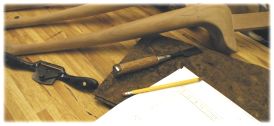 |
|
|
|
|
|
Part 1 |
Technically speaking, the copper veneer is .005" or 36 gauge. To get a real-world idea, the copper is almost twice as thick as the aluminum used to make a soda can or 7 times the thickness of aluminum foil.
A pair of scissors will work surprisingly well.
Check out this article which discusses the two most common methods for bonding copper to a project substrate.
The copper veneer comes in 20 different sizes ranging from 8" x 10" to 360 x 240".
With the right adhesive, you can bond the copper veneer to almost any substrate.
Generally speaking, you do not need a balance veneer with copper veneer since this material does not expand and contract with seasonal changes in humidity.
Paste Wax Lacquer Poured-On Epoxy
Most of the copper veneers are available with a wax finish, a lacquer finish, or no finish at all. There are some patina/color types which do not have a wax finish option simply because the colorant on the copper sheet requires lacquer to "lock in" the pattern. The wax finish often has slightly dull sheen and gives the copper a more organic appearance. A good coat of paste wax will bring out the best in the copper and protect it as well. Carnauba based car wax works quite well but any wax will work as long as it doesn't have "cleaner" or polishing agents in it. The wax finish option should only be ordered for your copper veneer if you have no plans to further protect the finish other than with additional coats of wax. The lacquer finish is glossy and can change the vibrance of certain patina colors. The high gloss nature of the lacquer finish can allow scratches to be more visible, but a coat of furniture-grade paste wax will help protect the lacquered copper from mild abrasion. It's also important to note that cracking and crazing can occur on lacquer copper veneers if the sheet is bent to a tight radius. Better protection is needed if you are using the copper veneer for table tops and shelving. To increase the durability of a lacquered copper sheet you can apply another coat of standard lacquer (available at most hardware stores) but always test it on a scrap piece of similar copper first. The ideal protective coating for bar top and counter tops is poured-on epoxy. Many hardware stores carry this type of finish. Be aware that poured-on epoxy finishes will not stick to a waxed copper veneer.
Yes! Copper veneer is suitable for counter tops and desktops as long as you adequately protect it with a poured-on epoxy finish.
If protected with wax or lacquer, it is possible that the patina could be scratched off. If this is a major concern, consider using an epoxy finish.
Contact cement never fully hardens so there is a bit of liability there. If you have a means of clamping the copper in place, then I highly suggest using TC-20 because it dries rock-hard. TC-20 is so strong that it has been used for copper flooring around CAT-scan equipment. Keep in mind that TC-20 takes 24 hours to cure. If you attempt to peel off the copper before 24 hours has passed, you will get some delamination. Simply wait for the full cure to occur and you will be astonished by the strength of this adhesive. Since TC-20 dries hard, you will find that completed copper panels can be trimmed very cleanly on a table saw.
Place the veneer face down on a smooth, clean surface. Gently scuff-sand the back of the copper veneer with 80 or 120 grit sandpaper. Be sure to scuff all parts that are to be bonded (especially corners and edges). Wear gloves while doing this to prevent any chemical residue from contacting your skin.
A vacuum press is ideal because it puts down an even amount of pressure and allows the use of TC-20 adhesive.
I've spoken to a few chemists about this question and each has come to the same conclusion. The chemicals used to make a solvent-based contact cement affect some copper, brass, and other metals. Not all copper is the same. Some have anti-tarnishing components added. Other coppers have material added that increases rigidity. The large companies that produce contact cements try to avoid the liability associated with a failure of their product when used to bond a material that can have so many variations in content.
Yes and no. The chemists that I worked with said that sovent-based contact cements might not last as long as copper panels bonded with TC-20. The durability estimates with solvent-based contact cement ranged from 5 to 20 years. To be clear, this is not a time frame for total delamination of the copper from the substrate. Instead, this is the amount of time before the contact cement will break down and begin to allow weakening of the bond strength. Because there is no long-term interaction between the chemicals in TC-20 and the copper, it's durability range is indefinite.
This type of contact cement requires a porous surface to bond properly. Since the copper sheeting is not porous, water-based contact cement will not work.
If the copper is protected with epoxy or lacquer, it will "age" considerably slower than if simply waxed. The copper patina will typically fade and the copper itself will develop a warm brown tone.
If you find copper veneers with names like "Azul", "Zebra", "Rojo", "Verde" and "Bamboo" then it is very likely that the reseller is purchasing the copper from the same source. This source has required allof us to sell his copper at the same price. At least we offer free shipping on the larger sheets!
Most places that sell this color copper are using the stock photographs provided by the manufacturer. I used these stock images for the first few months that we offered the copper veneer. Within that time, several customers complained that the images we not fair representations of the true colors of the copper. The colors were saturated and the contrast of these manufacturer-provided images were computer enhanced. So I set up a jig for my camera and took pictures of each patina style. Then I adjusted the images on a color-calibrated monitor and since then, I've received no complaints about the copper.
I've seen a huge number of copper projects completed with the 36 gauge copper and none of these required the heavy duty version when protected with a suitable finish. Considering the expense of crating and shipping the heavy copper sheeting, I doubt there is enough "demand" to warrant adding it to my website. |
|
|
|



 If you've been looking for something truly unique for your next veneering project, this is it. No two sheets are identical and each is an amazing work of art by itself. Imagine the reaction your family, friends, and customers will have when presented with a one-of-a-kind copper veneer work of art. Best of all, this copper is easy to use and requires no harmful chemicals. Here are answers to the most common questions about copper veneer.
If you've been looking for something truly unique for your next veneering project, this is it. No two sheets are identical and each is an amazing work of art by itself. Imagine the reaction your family, friends, and customers will have when presented with a one-of-a-kind copper veneer work of art. Best of all, this copper is easy to use and requires no harmful chemicals. Here are answers to the most common questions about copper veneer. 